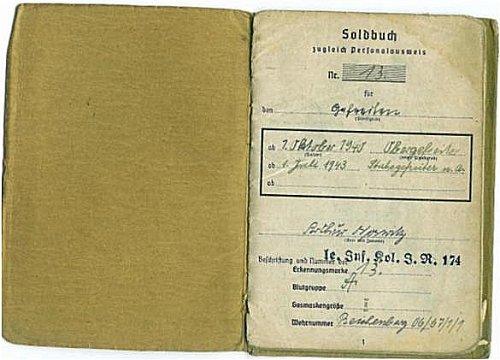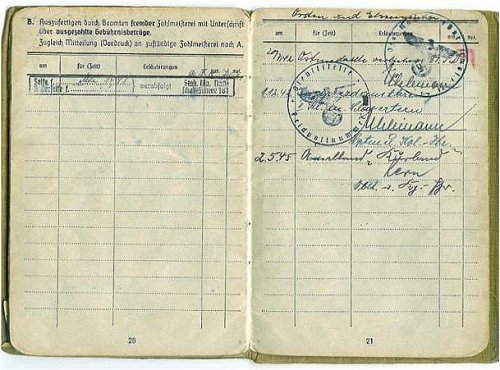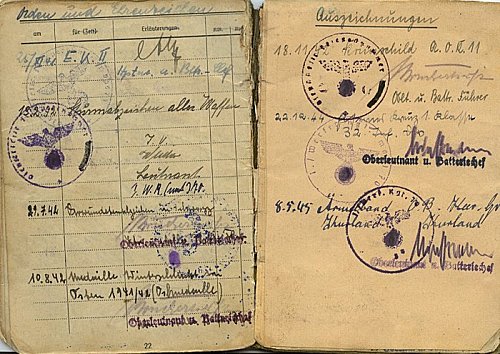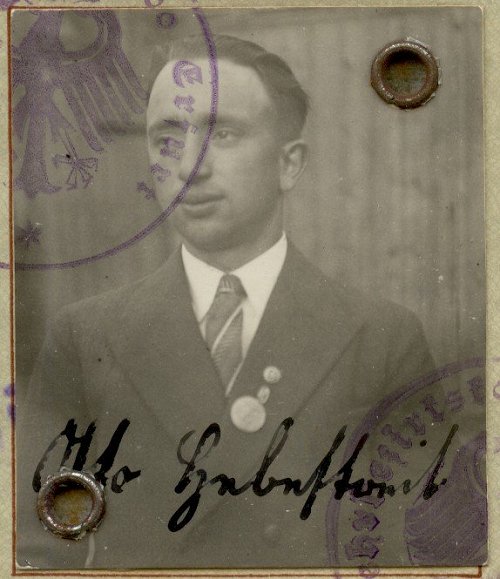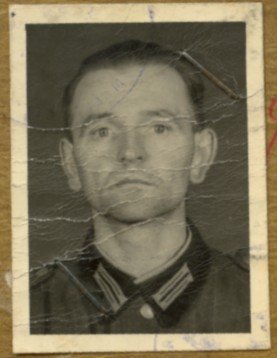
By Scott Pritchett
KURLAND CUFFBAND RELATED DOCUMENTS
Documentation pertaining to the award of the KURLAND cuffband is scarce due to the late institution of the award and the isolated condition of the command, as well as the subsequent surrender to the Soviets. However, Soldbuch and, more rarely, Wehrpaß books with Kurland related entries, award notification telegrams, and actual award documents for the cuffband do infrequently come on the collector's market. As rarities, and therefore items that command higher prices, documents related to the Kurland campaign are more prone to be forged and faked. Thus, any serious documents collector should have available references that record battle locations, dates, commanders and their related units, and order of battle information in order to guard against the acquisition of faked documents. The extremely few award document reference books that illustrate and describe authentic examples of original KURLAND award documents are all absolutely required, as no single reference stands completely on its own for complete information. In this article is a compiled general order of battle for all branches of the Wehrmacht that had forces committed during the period that qualified a soldier for the cuffband - 15 September 1944 to the end of the war. Except for separate units below division level, those that do not conform to a divisional structure, and unique or special units that participated in the campaign, this list does not break down below the division level - and in some cases, such as the Kriegsmarine, does not include higher organizational structures - so there is much room for added detail. This is merely provide this as a starting point for collectors to research a document they are considering adding to their collection. There are several good references that can add to this level of detail - however, many of the more detailed books are expensive. The investment can be worth it for serious document collectors, but many members of the Association who already have the books usually seem willing to assist a collector who does not.
It should be noted that throughout the eight-month campaign, several divisions such as the 14. Panzer Division, and various other units were in fact withdrawn from the bridgehead or destroyed, so the units shown did not necessarily fight the entire campaign, but nonetheless their members qualified for the cuffband.
ORDER OF BATTLE
Heeresgruppe Nord - Changed to Heeregruppe Kurland on 25 January 1945:
Army Formations :
- 16. Armee
- 18. Armee
Corps Formations :
- Armee Korps: I, II, X, XVI, XXXVIII
- Panzer Korps: XXXXIII and L
- Armee Abteilung Narwa
- III (Germanishes) SS-Panzer- Korps
- II SS-Korps
- VI SS Freiwilligen-Armee-Korps
Units routinely came under different command relationships between these two armies as well as between the corps.
HEER Formations :
- 11 Infanterie, 21 (only in battle group strength having been destroyed in the Russian summer offensive against Heeresgrupped Center), 24, 30, 31 Volks-Grenadier, 32, 52 Sicherungs Staff, 58, 61, 81, 83, 87, 93, 121, 122, 126, 132, 201, 205, 207 Sicherungs, 218, 225, 227, 263, 281 Sicherungs , 285 290, 300 Sicherungs, 329, 389, 563 Volks-Grenadier, 4 Panzer, 12 Panzer, 14 Panzer, 7. Panzer Division (possibly), elements of Schwere-Panzer Abteilung 502
- Panzer-Fusilier-Regiment Großdeutschland (operated in the vicinity of Heeresgruppe Nord only very early in the campaign, and then only briefly. Most likely its members did not qualify for the award)
- Heeres-Artillerie-Abteilung 814
- Heeres-Flak-Abteilung 276 (attached to 14. Panzer Div. at least in Sep.)
- Heeres-Flak-Abteilung 290
- Flak-Regiment 60
- Panzer Brigade 101
- Schwere-Panzer Abteilung 510 w/ 3./ Schwere-Panzer-Abteilung 502
- Schwere-Artillerie-Abteilung 436
- Sturmgeschutz-Brigade 184
- Sturmgeschutz-Abteilung 600
- Sturmgeschutz-Brigade 912
- Sturmgeschutz-Brigade 227
- Panzer-Brigade Kurland
Waffen SS Formations :
- 11. SS Frewilligen-Panzergrenadier-Division, Nordland
- 4. SS-Freiwilligen- Panzergrenadier - Brigade Nederland
- 19. Waffen-Grenadier-Division der SS ( lettische Nr. 2)
- 15. Waffen-Grenadier-Division der SS (lettische Nr. 1)
Numerical designations were dropped on 11 Oct 1944 and brigades were redesignated as divisions.
Luftwaffe Formations :
- 21 Luftwaffen Feld,
- 12 Luftwaffen Feld Divisionen
- Jagdgeschwader 54
- 6. Flak Division
- Luftflotte 1 (redesignated Luftwaffenkommando Kurland on 17 April 45)
- HQ., II./ and III./ Schlacht-Geschwader 3.
- III./ Schlacht-Geschwader 4.
- Nacht-Schachtgeschwader 3
- HQ., 1., 2., Nahaufklarungsgruppe 5.
- HQ., I., and II., Jagdgeschwader 54.
- Various (up to 100) batteries of Flak (2. and 6. Flak-Divisionen)
Kriegsmarine Formations :
- Marine Artillerie Regiment 10, Abteilung 530, 532, 536
- Marine Flak Abteilung 712
- Marine Festungs Pioneer Bataillon 312
- 9 Marine Kraftfahr Abteilung
- Marine Artillerie Arsenal
- Marine Ausrustungsstelle
- 9 Sicherungs Division comprised of numerous Kriegsmarine special units (Torpedo Boots, Minenesuchboote (Brummer, Linz, M328 -not inclusive), Raumbooten (R22), Kriegfiskutter, Motorfishkutter, Vorpostenbooten, Landungsflotille, Artillerietraeger (7), Hospital Ship Oberhausen, Stutzpunk Bohnsak, Sperrbrecher, Emden, Leipzig, Prinz Eugen, Admiral Hipper, Admiral Scheer, Lutzow, various destroyers, Schnellbootshulflotille, Werkstattboot (Nidden, Cranz - not inclusive)
- 6. Zerstorer-Flotille (Z 25, 28, 43, Karl Galster)
- 5 Torpedoboot-Flotille (T23, 24, 28, 33, 35, 36)
- 2 Torpedoboot-Flotille (T1, 3, 4, 5, 8, 9, 11, 12, 13, 16, 19, 21)
- 4 Zerstorer-Flotille (Z34, 38,31, 35, 39)
- 3 Torpedoboot-Flotille (17, 19)
- F506 (Frachter)
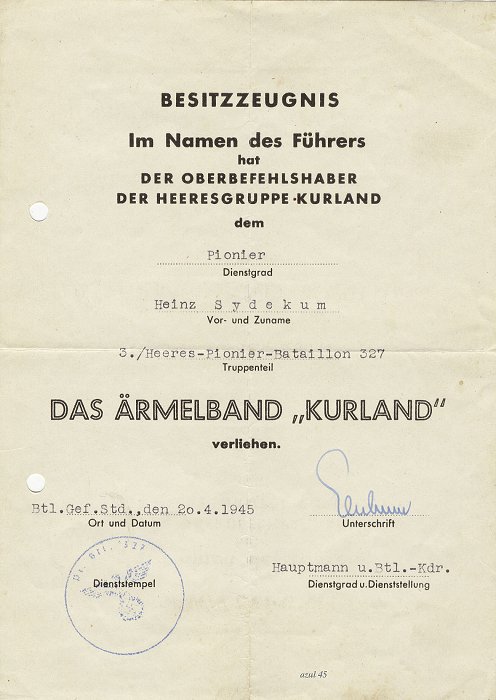 |
|
KURLAND award document presented to Sydekum. It is representative of the standard pre-printed style almost always seen - Courtesy Manuel R. collection. |
Award documents probably exist in both pre-printed and field made form, however, the pre-printed form is the more usual one to be encountered by collectors. Telegrams announcing the cuffband award may also be encountered. Pre-printed versions of the award document are highly standardized. T he DIN A5 size (150mm by 210mm) was used. The example above was the only unpublished, collector-donated document found by the time this article was hung on the web. It is an example to army soldier, but would have been standard for all branches of the Wehrmacht. However, pages 64 and 65 of Gordon Williamson's and Thomans McGuirl's German Military Cuffbands 1784-Present show examples of examples for Luftwaffe and Kriegsmarine recipients, respectively. Both formats conform to that described below. Additionally, Forman's Guide to Third Reich German Award Documents...and Their Values, Vol 1, pages 287-289 show four more examples, three Heer and one Kriegsmarine, which also exhibit the same format. Detlev Niemann's Bewertungs-Katalog ORDEN UND EHRENZEICHEN DEUTSCHLAND 1871-1945 No 1 shows a Kriegsmarine example in standard format. Lastly, Emile Caldwell Stewarts original publication "German Military Award Documents 1939-1945" shows a Luftwaffe version on page 150 and a field version to a Luftwaffe member on page 151.
The wording and format on the KURLAND award document conforms to the information found on most award documents. The pre-printed version described is printed in what we would probably today call a century gothic font.
B E S I T Z Z E U G N I S
Im Namen des Fuhrers hat DER OBERBEFEHKSHABER DER HEERESGRUPPE KURLAND
dem
…………………………….. Dienstgrad
…………………………………… Vor- und Zuname
………………………………….. Truppenteil
DAS ARMELBAND ,,KURLAND"
Verliehen
……………………………… ……………………….. Ort und Datum Unterschrift
………………………… Dienstempel Dienstgrad u. Dienststellung
The award was made in the name of the Fuhrer, but was bestowed by the commander of Army Group Courland (Heeresgruppe Kurland). From known originals, it appears that the signing authorities ranged over a wide array of ranks, from flag/general officers to field grade officers in a variety of positions, which varied as well according to the particular branch of the Wehrmacht. This was not always the case with awards - some having definitive issuing levels - which tends to help in establishing authenticity of a document. However, due to the conditions in early 1945, it makes sense that the KURLAND band would be awarded under a variety of authorities. Issue locations varied as well. Readers can refer to the Association web article on the AFRIKA cuffband for more complete information as to meanings of abbreviations of issuing headquarters.
Dates on award documents will vary too. The date of 20.4.45 seems to be a common date for the KURLAND band. Other dates observed, especially on Kriegsmarine and Luftwaffe award documents include 4.5.45, 7.5.45, 8.5.45, and even 13.5.45, this latter date illustrating the renowned German penchant for effective and efficient administration lived up to its reputation, and the machinery continued to function for some time after capitulation.
The awarding of a KURLAND band was also noted in a member's Soldbuch and Wherpaß. Entries in the latter appear more rarely. Wehrpaß books stayed with the units, whereas the Soldbuch remained on the soldier. Many units, on order from Heeresgruppe Kurland destroyed their records in the final days of the war. Regardless, the typical entry would show on page 21 or 22 of the Soldbuch and state: the date of issue - ärmelband ,, Kurland" - and the authority/officer that made the entry. Again, the latter will vary. Pictured below are several Soldbuch entries.
|
|
Gefreiter Arthur Hennitz was a member of Infanterie Regiment 174 which formed part of the 81. Infanterie Division. This division fought in France and Russia, where it distinguished itself repeatedly and most notably around Leningrad and Demyansk. It ended the war in the Courland bridgehead. Hennitz's entry shows an award made on 2 May 1945, just a week before the end of the war. The entry was made by an Oberleutnant who was his company commander. The Soldbuch and cuffband are reported to be vet acquired, the cuffband being found in the Soldbuch - Courtesy Jim Pool. |
 |
|
Another Heer Soldbuch entry - Courtesy Gordon Williamson. |
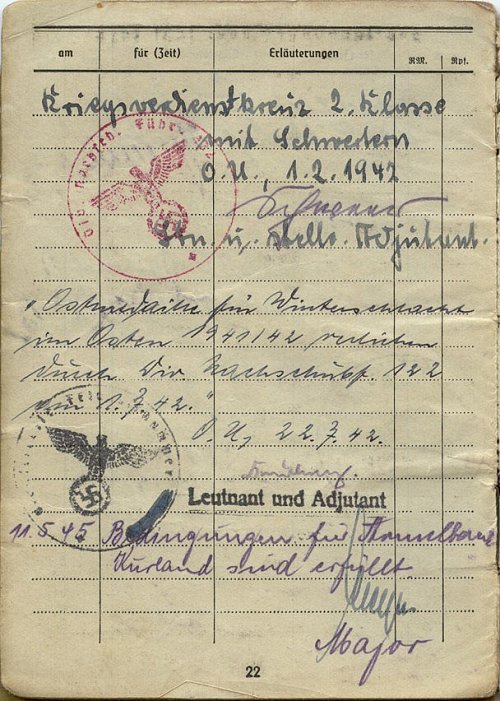 |
| Unteroffizier Walter Augustin served on the staff of the 24. Infanterie Division when it fought in Courland. The 24. was another division with a distinguished combat record and proven reputation, fighting in Poland, the Crimea and, for the last two years of the war, as part of the Germans' northern armies. It went in to Soviet captivity after the war's end. Augustin received an entry in his Soldbuch on 20 April 1945 - again, a very common date related to the awarding of this decoration. He was a well-decorated veteran of the entire war receiving the EK II on 12.12.39, the Ostmedaille on 15.3.42, the Rumanian Anti-Communist Medal on 17.11.42, the Krim Shield on 30.12.42, and the KVK II on 20.4.45 along with his KURLAND band. It is interesting to note that an entry made on 14.5.45 records that his Wehrpaß was destroyed in enemy fighting (Feindwirkung ) on that date…evidence that shows not all forces capitulated on 8 May 1945, especially in Courland Soldbuch entry - Courtesy of ERICH CRACIUN /Old Europe. This authorization is only valid for publication on WEHRMACHT AWARDS. |
|
|
|
Soldbuch entry for Obershirrmrister Heinrich Birkenhake of the 122. Infanterie Division, who is pictured at right. His entry at the bottom of the page is interesting in that it does not state the award as usually seen, but rather states "Conditions for the Kurland award are fulfilled". Note also that this entry was recorded on 11.5.45 - several days after surrender. Birkenhake would die in captivity less than a year later, in January 1946. Courtesy of the Ian Jewison collection. |
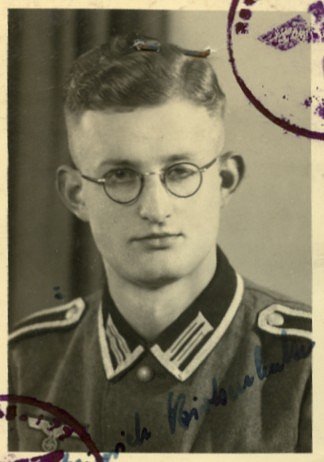 |
|
|
| Another pair of photos (portrait is from his Wehrpaß) showing the Soldbuch entry for Oberwachmeister Otto Hebenstreit and the alte Hasse. This award was made on 8.5.45 - the last day of the war. Hebenstreit was a well decorated veteran of the Werfer Regiment 70, having previously earned the EK II and EK I, the Allgemienes Sturmabzeichen (GAB) and the Kuban Shield. Courtesy the Ian Jewison collection. |

|
|
Gefreiter Karl Knop also served with the Werfer Regiment 70 and saw his award made 1.5.45. The notation is also an uncommon format. Courtesy the Ian Jewison collection. |
|
|
|
Scott Pritchett collection |
Likewise, the Wehrpass will reflect award entries on page 38. Shown is the entry made in the Wehrpaß of August Weber as a member of Infanterie Regiment 503, 290. Infanterie Division. Weber also served briefly with Infanterie Regiment Großdeutschland, coming from Infanterie Regiment 92 when its third battalion was used to expand the Großdeutschland to regimental strength. Again, the 290. Infanterie Division was a hard fought division. It was accustomed to fighting surrounded, having fought in and broken out of the siege at Demyansk, but Weber was not a member of the unit at the time. His KURLAND band entry shows the familiar 20.4.45 award date and the notation Armelband ,,Kurland". Weber was also decorated with the IAB on 2.9.44, the Wound Badge in Silver on 18.8.44 and the KVK I on 12.1.45.
 |
| This last picture again shows the April award date in a Wehrpaß. The wording of the entry is different from most, noting Kurland-Band versus the Armelband ,,Kurland" form of notation. Also interesting is the sometimes seen means of recording the month in Roman numerals as 20. IV.45 - Courtesy Jacques Calero collection. |
![]()
© Copyright Wehrmacht-Awards.com LLC |
